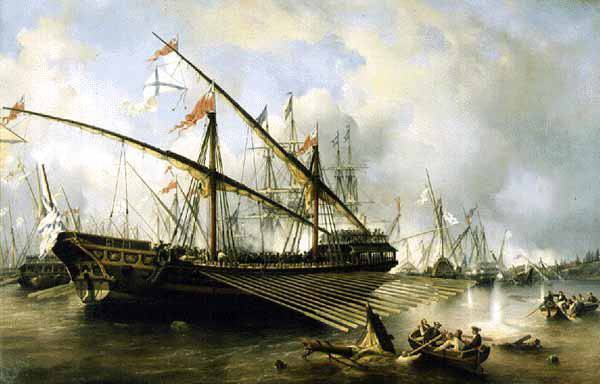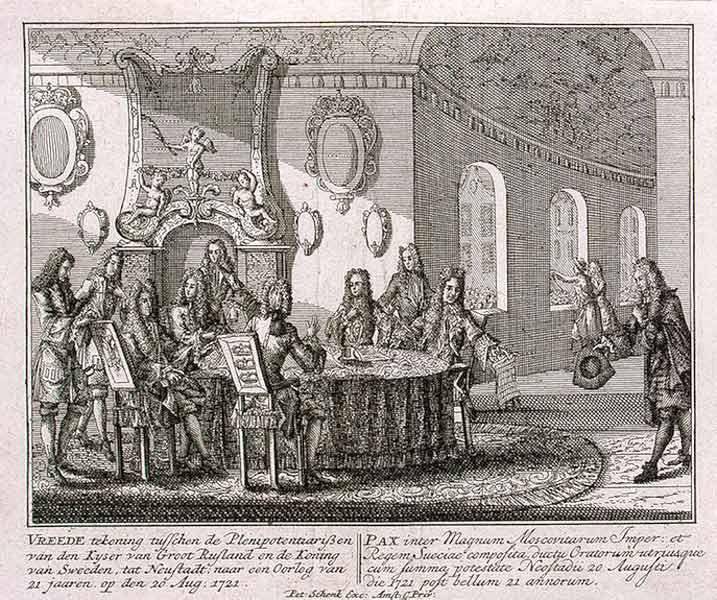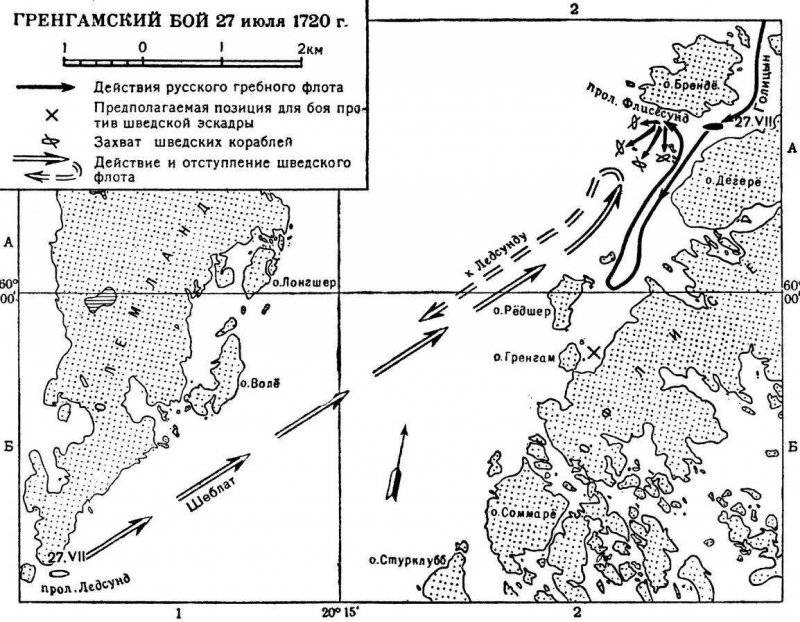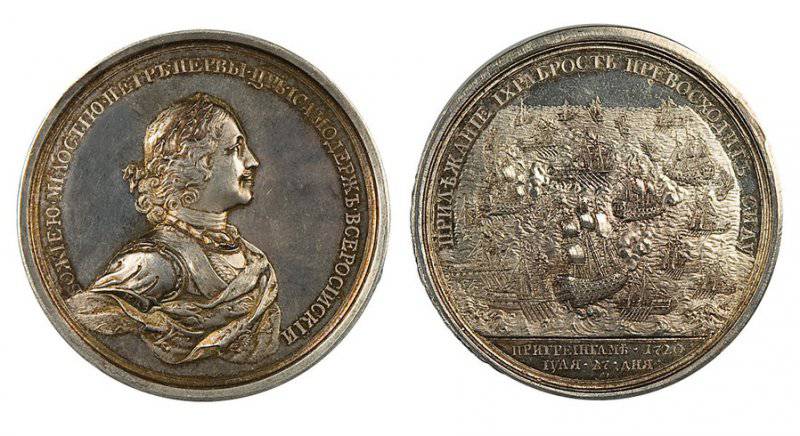The last battles of the Northern War: the sea, land and diplomacy. H. 2

The start of the 1720 campaign of the year was characterized by the fact that Sweden almost completely exhausted its military potential and became dependent on British diplomacy. London tried to create a broad anti-Russian coalition to "protect Europe" from Russia. January 21 (February 1) was signed a union treaty between England and Sweden. London pledged to send a strong squadron to protect Sweden from the “Muscovites” and pay subsidies to Stockholm before the end of the war. At the same time, the British believed that they were not in a state of war with Russia, although they sent ships for military action. It was reported that the trade of England and Russia will be preserved. The British promised the Swedish government to return Estland and Livonia.
At the same time, under pressure from British diplomacy, Sweden signed an agreement with Prussia. The Swedes gave Prussia their possessions in Pomerania. The Prussian state promised not to assist Russia. True, King of Prussia Friedrich Wilhelm I was not going to quarrel with Russia. In the summer, a special declaration was issued, which reported that Prussia did not undertake any obligations against the Russian state. In addition, at the beginning of 1720, Saxony and Rzeczpospolita signed peace with Sweden.
From autumn 1719 to July 1720, the British put pressure on Denmark. London wanted Denmark to enter into an alliance with Sweden against Russia. But the Danes had too much controversy with the Swedes. Only 3 (14) July Sweden and Denmark signed a peace treaty. Copenhagen received small territories in Schleswig-Holstein, a monetary contribution and resumed collecting duties from the Swedish courts for passing through the Suund Strait.
In general, the attempt of the British to create a broad anti-Russian coalition, to draw Prussia, Austria, Poland, Holland and Denmark to war with Russia was not crowned with success. There were serious contradictions between the countries. In addition, the policy of London was hindered by Paris. Russia, for its part, tried to explain in European capitals that it does not claim territory in Germany. Back in 1719, the Russian forces, which remained in Mecklenburg-Pomerania and Poland, were relegated to Riga. Peter in April 1720 of the year issued a third declaration that allowed the British to trade in Russia. But London continued an aggressive policy. The Russian envoy in London, F. Veselovsky, said that the British government equips a fleet of 30 pennants, with a crew of more than 9 thousand people.
Peter planned to start military operations in the winter. To this end, it was planned to send Cossack parties on the ice of the Gulf of Bothnia. They were supposed to attack the Swedish coast. Warm winters and weak ice cover forced the Russian command to abandon this plan. Therefore, it was decided to repeat the successful experience of 1719 - the actions of the galley fleet with the landing. On March 4 (15), an action plan was developed. A third of the galleys were supposed to go to the city of Vasya, then cross the Gulf of Bothnia and act in the Umeå area. It was a distraction. The main forces of the galley fleet were to attack in the area of the city of Gavle. The sailing fleet received the task of covering up the actions of the galley fleet.
14 (25) April squadron Goft as part of 7 ships went to explore the shores of Sweden. On April 22 (May 3), an order was sent to Revel by P. M. Golitsyn to prepare guards regiments and galleys for the march. At the end of April, the galley fleet consisting of 105 galleys, 110 island boats, 8 brigantine and airborne troops in 24. Thousands of people left Abo in the direction of the Aland Islands. Messages by the Russian ambassadors B. Kurakin from The Hague and V. Dolgorukov from Copenhagen also contributed to the active actions of the Russian galley fleet. They informed Petersburg about the readiness of Sweden and England for the 1720 campaign of the year. According to the ambassadors, Sweden was preparing 24 thousand airborne troops and transport for him. For actions on the sea equipped 17 ships. The Swedish government awaited the arrival of the British fleet and the help of ground forces from Hanover. Ambassadors reported that the process of collecting the Swedish troops is difficult because of the “lack of people”, and the British fleet is delayed.
Therefore, the Russian command acted in advance. 24 April (5 May) to the coast of Sweden from Abo left the detachment of the brigadier Mengden in the 35 gallery with 6,2 thousand troops. The detachment went to the Swedish coast between Old and New Umea. Mengden landed amphibious forces, which ravaged the enemy land to a depth of 30 km. 8 (19) May squad successfully returned to base. This expedition showed that the defense of England would not save the Swedish coast from Russian attacks.
The 12 (23) of May the British fleet united with the Swedish Navy and moved to the shores of Russia. At the end of May 1720, the British-Swedish fleet appeared at Revel. The British squadron consisted of 18 battleships (which had 50 to 90 guns), 3 frigate, 2 bombing ships, 1 brander. The Swedes had the 7 battleships, the 1 pink, the 1 bombardier and the 2 brander. Apraksin asked the British admiral Norris for the purpose of the appearance of the fleet from Revel. Norris wrote an answer to Peter’s name, but Apraksin, not having the authority to receive letters addressed to the king, did not take it. Norris wrote a second letter in which he said that the arrival of the British fleet in the Baltic Sea was done solely for the purpose of mediating negotiations between Russia and Sweden. Admiral Apraksin, in his reply, reminded the Briton that they were sending an envoy for the diplomatic mission.
At that time, while the admirals were in correspondence, the British carried out measurements of the depths in order to ascertain the possibility of landing troops. They were convinced that an attack on a well-fortified coast without significant land forces is impossible. In addition, the British did not know the waters of the area. 2 (13) June Norris received a message about the attack of Russian forces on the Swedish coast (the attack of Mengden's detachment) and the allied fleet hastily retreated to Stockholm. The campaign of the Anglo-Swedish fleet ended fruitlessly, except for the burned bathhouse and the hut on the island of Nargen, where the allies landed.
The arrival of the British fleet did not change Peter’s plans. 12 (23) June, a naval squadron under the command of Goft departed from Kotlin for cruising between Gangut and Rogervik. The galley fleet was taken from the island of Lemland to the coast of Finland to ascertain the further actions of the Anglo-Swedish fleet.
Battle of Grengam 27 July (August 7) 1720
There are only a few reconnaissance and patrol boats left on Åland. After leaving the islands of the Russian fleet there appeared Swedish galleys. One of the Russian boats ran aground and was captured by the enemy. No member of the crew was taken prisoner. But Peter expressed discontent and ordered M. Golitsyn to conduct reconnaissance and clear Åland from the Swedes. At that time, Aland had two Swedish squadrons: under the command of K. Schöblad (1 battleship, 2 frigate, 2 galleys, galliot, Scherbot 2) and the second under the command of K. Wahmeister (3 battleship, 12 frigates 8 gal,). brigantines, 2 haliots, 1 shnyava, 1 brander, and 1 scherbot).
On July 24 (August 4), a Russian squadron under the command of Golitsyn consisting of 61 galleys and 29 boats with 10,9 th. Paratroopers came to Abo. July 26 (August 6) Russian forces approached the Aland Islands. Reconnaissance boats spotted the Swedish squadron of Schobladus between the islands of Lemland and Frisberg. Because of the strong wind and big waves, it was impossible to attack her, the Russian galley squadron was anchored, waiting for good weather so that you could fight with the enemy. But the wind did not subside. The next day, the military council decided to go to the island of Grengam in order to prepare a good position for the attack.
When the Russian galleys began to emerge from under the cover of Rödscher Island in the direction of the Fliesösund Strait between the islands of Brende and Flísø, the Schoblad squadron was removed from the anchor and went to intercept. The forces of the Swedish vice-admiral were strengthened and included 14 pennants: 1 battleship, 4 frigate, 3 galleys, 1 shnjava, 1 galliot, 1 brigantine, 3 scherbot. The Russian squadron entered the strait, where the movement was complicated by the presence of shoals and reefs. When the Swedish frigate 4, which was at the forefront, were drawn into the strait, Golitsyn ordered them to be attacked. Sheblad was following the frigates on the battleship and, seeing the attack of the Russian forces, ordered him to stand in line with the sides to the enemy galleys. Large Swedish ships had a large turning radius and fell into the trap - frigates "Venkern" (30 guns), "Stor-Phoenix" (34 guns), turning, stranded. Russian galleys surrounded them and went to the boarding. Boiled furious battle. Swedish ships did not save either high boards or boarding nets, the frigates were captured.
Two other Swedish frigates - the 22-gun "Kiskin" and the 18-gun "Dansk-Ern", tried to retreat. But they were prevented by their own flagship. Initially, Sheblad, not paying attention to the desperate resistance of his frigates, tried to make a turn in the wind and go into the open sea. Then, taking into account the factor that there was no time for maneuver, he ordered the anchor to be dropped, without lowering the sails. The ship turned on the spot, caught the wind. Sheblad ordered to cut off the anchor and go to the open sea. This maneuver closed the way to the Swedish frigates. “Kiskin” and “Dansk-Ern” were also boarded. Russian galleys were chasing the Swedish flagship, but he was able to escape.
4 enemy frigates were captured, 407 people were captured, Swedes 103 died in battle. Russian squadron lost 82 killed, 236 wounded. About the fierceness of the battle says the fact that the 43 galleys had some kind of damage. This victory made an impressive impression in Western Europe. Europe saw that, even in the presence of the English fleet, the Russians continued to beat Sweden. It was the last major battle of the Northern War.
Medal "In honor of the capture of 4-s of Swedish frigates near the island of Grengam. 27 July 1720."
Nishtadt World 30 August (10 September) 1721 of the year
After this battle, the Russian fleet retired to its bases. The 1720 military campaign of the year was completed. But the struggle continued on the diplomatic front. In June 1720 of the year, the Swedish king Fredrik I of Hesse declared that Sweden could not fight unless Prussia and France were not on her side except England. After the Grengam battle, the Swedish government was sober, the Swedes began to realize that they were mistaken when they did not accept the conditions of Russia during the negotiations in the Alands, and believed the promises of the British, making territorial concessions in favor of Prussia and Denmark. The British government promised a lot of things, but they were not really going to fight. The military demonstration of the British fleet did not give positive results. Rally anti-Russian coalition did not work, wishing to fight for British interests was not.
In August 1720, Paris, having assessed the situation, offered its mediation for the settlement of relations between St. Petersburg. Stockholm and London. This made it possible to increase the influence of France in the region. London was forced to accept the idea of peace negotiations. The British government refused to Stockholm, when he proposed to leave the British ships in the Swedish ports for the winter. English King George wrote a letter to the Swedish king, proposing to immediately make peace with Russia. In fact, the British deceived the Swedes, because in 1719 and the first half of 1720, they said the opposite and persuaded Sweden to continue the war, promising full support.
9 (20) of August, the Russian representative A. I. Rumyantsev was sent to Sweden. He congratulated Fredrik on his accession to the throne and offered to conclude a temporary truce and exchange prisoners. The Swedish government was disappointed; in Stockholm they expected Rumyantsev to bring the terms of a peace treaty. Peter was not going to take the initiative to conduct peace negotiations and waited for proposals from Sweden. 12 (23) November Rumyantsev returned to St. Petersburg and informed the king that the Swedish government wanted peace. Peter sent a letter to the Swedish king in which he proposed direct negotiations in the Finnish cities of Nishtadt or Raumo. Nishtadt was chosen as the place of negotiations. The hopes of the Swedes that British and French diplomats would help them were not justified.
The Swedes initially tried to impose their own conditions on Russia: to cede only Ingria with Petersburg, Narva and Kexholm. Russia did not put forward new conditions (apparently, it was a mistake, it was possible to take all of Finland or part of it, punishing Stockholm for the failure of negotiations at the Aland Congress), and firmly held the positions of the program put forward at the Aland Congress. Petersburg demanded to give Russia Estland with Revel, Livonia with Riga, Ingermanland, Vyborg and part of Karelia. As before, Russia did not demand to give her Finland. In addition, she offered a number of concessions - monetary compensation for Livonia, to give a guarantee that St. Petersburg would not support the claims of the Duke Karl Friedrich Holstein-Gottorp to the Swedish throne.
The Swedish envoy Kampredon, who offered the preliminary conditions, found out during his visit to Russia that Stockholm had incorrect information about the state of affairs in the Russian state. Russia is much stronger than thought in Sweden. The treasury of the Russian tsar was full. The industry is constantly evolving, revenues are growing. According to his information, the Russian regular army reached the number of 115 thousand people and was in excellent condition (these data did not differ much with real numbers, and with the irregular troops the Russian Armed Forces were twice as large). In Finland, there were 25 thousand soldiers and the number of local forces were going to bring thousands of bayonets to 40. In order to transfer this force to Sweden, Peter had to the 300 galleys and about 1100 transports. For the 1721 campaign of the year, Russia was ready to set up 29 battleships, 6 frigates with 2128 guns. Russian serf artillery had 8100 guns, only Petersburg defended 590 guns. Therefore, Kampredon returned to Sweden, believing that it was necessary to make peace on the conditions proposed by Russia.
Sweden was in poor condition. A long war brought the country to financial and economic collapse. The troops did not receive a salary for a long time, they also cut it in half. In May, the 1721 of the year, the military openly declared that if they did not receive the money, they would add up weapon during the landing of Russian forces in Sweden. The army and the population were demoralized. For the 1721 campaign, only 11 battleships were able to prepare, the rest were in a state of disrepair. Rumors began to spread that 20 thousand Austrian, 20 thousand French, 16 thousand British, 10 thousand Danish soldiers were sent to the aid of Sweden. Petersburg was not to be deceived by such disinformation: Russia had agents in all European capitals.
On April 24 (May 5) the Swedish Commissioners arrived in Nishtadt - J. Lilienstedt (Lilienstate) and O. Strömfeld. A little later, the Russian delegates arrived there - Jacob Bruce, Andrei Osterman. It should be noted that during these negotiations the Swedes waited, hoping for the help of England. London at this time sent a fleet to the Baltic Sea, he had to defend the Swedish coast. In late April, the British fleet (the 25 of the battleships and the 4 frigate) embarked at Bornholm.
The Russian command decided to put military pressure on the Swedes. 17 (28) in May, a detachment under the command of P. Lassi, who had a 30 gallery and a number of other ships during the 5,4 thousand landing, landed troops at the Swedish fortress of Gavle. Russian troops ravaged the Swedish possession and reached Umeå without encountering resistance. Swedish troops retreated without a fight. The 17 (28) July Lassi squad returned successfully. This raid had a tremendous moral impact on Sweden. Lassi reported that Sweden is in "great fear." The entire northeastern coast was defenseless, the last relatively combat-ready units were braced toward Stockholm. Sweden could not repel even a rather small landing.
May 30 (June 10) Swedish delegates asked St. Petersburg to stop hostilities. 7 (18) June, the Swedes offered to conclude a preliminary peace treaty. Peter considered that this was another attempt to draw time and refused. Seeing that the Swedish side continues to play up, July 30 (August 10) Peter ordered M. Golitsyn to leave with all the galley fleet and landing forces to the Aland Islands. At the end of August 124 galleys under the command of Golitsyn went to Aland and conducted reconnaissance off the coast of Sweden. The signal was understood. Russian troops were ready to seize Stockholm.
30 August (10 September) 1721, in the city of Nishtadt, a peace treaty was signed between the Russian Kingdom and Sweden, which ended the Northern War of 1700 — 1721. Between the parties was established "the eternal true and inviolable peace on earth and on water." Sweden gave Russia “to perfect undisciplined eternal possession and property” of Estonia, Ingermanland, Livonia, a part of Karelia with the Vyborg district, the cities of Riga, Pernov, Revel, Dorpat, Narva, Ezel islands and Dago. For these territories, the Russian kingdom paid compensation to Sweden in 2 million efimkov (1,3 million rubles). Finland was returning to Sweden. The treaty provided for the exchange of prisoners, an amnesty for "criminals and deserters" (except for supporters of Ivan Mazepa). In addition, the agreement reaffirmed all the privileges granted to the Ostsee nobility by the Swedish government: the German nobility and the Baltic cities retained their self-government, class organs, etc.

The signing of a peace treaty in Nystadt. 30 August 1721. Engraving P. Schenk. 1721 year.


Information